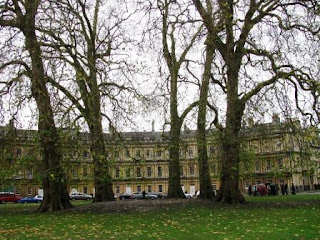I'll begin this post this way: I love Bath. Maybe more than any other English town I've seen so far. Before coming to England, it was one of the destinations high up on my must-see list (in addition to Stonehenge and Cambridge), and today I had the opportunity to go there on a class field trip. I was not disappointed!
Take a natural hot spring that provided the roots for a Roman town, then later a flourishing resort escape and artists' abode for the wealthy, all situated against a gently-rolling-hills landscape, and you've got Bath. The
Take a natural hot spring that provided the roots for a Roman town, then later a flourishing resort escape and artists' abode for the wealthy, all situated against a gently-rolling-hills landscape, and you've got Bath. The
 current architecture there is mainly of an eighteenth-century neoclassical style (see how much architecture class is teaching me?), whose clean-cut, elegant buildings I found wonderfully attractive. These buildings had just the right mix of the historic/classical, and enough of a taste of the modern, to make them really beautiful. Adding to the appeal of the city was its interesting layout, straight sloping streets combined with curving roads and sprawling open space. It turned out bigger than I expected, much more spread-out than medieval towns like Winchester, and when our class toured the city, up into the hills past the resort apartments the gentry built for themselves to stay in during "the season," we passed such grand curving landmarks as the Circus and the Crescent. And got a pretty magnificent view besides - now if only it hadn't been rainy!
current architecture there is mainly of an eighteenth-century neoclassical style (see how much architecture class is teaching me?), whose clean-cut, elegant buildings I found wonderfully attractive. These buildings had just the right mix of the historic/classical, and enough of a taste of the modern, to make them really beautiful. Adding to the appeal of the city was its interesting layout, straight sloping streets combined with curving roads and sprawling open space. It turned out bigger than I expected, much more spread-out than medieval towns like Winchester, and when our class toured the city, up into the hills past the resort apartments the gentry built for themselves to stay in during "the season," we passed such grand curving landmarks as the Circus and the Crescent. And got a pretty magnificent view besides - now if only it hadn't been rainy!Now, Bath (being Bath) also has, well, baths, long regarded to have healing and even mystical properties. The oldest among these is the excavated ruin of the ancient Roman bathhouse and city center, which I got to see with two friends after our class tour had dissembled for a few hours of free time. The foundations are all that remain, along with many artifacts,
 but the hot spring still fills the basins of the large stone baths themselves, which are remarkably intact. Having taken Latin in high school and having learned about the Roman bathhouse tradition, I found it fascinating to see this location for myself. (Random highlight: I unexpectedly ended up getting free admission once the audio-tour-desk clerks found out I was deaf. Hey, awesome.) The other eighteenth and nineteenth century baths, I didn't get to see except from the outside, but we did discuss the old genteel traditions of spending the winters here to socialize and relax and cure gout and other maladies - basically what you'd expect from reading Jane Austen. Bath's famed hot spring water was available for tasting, but I ran out of time to try it! (Although, from what I've heard, I wouldn't especially fancy gulping down a mineralized, sulfur-y, questionably beneficial liquid anyway.)
but the hot spring still fills the basins of the large stone baths themselves, which are remarkably intact. Having taken Latin in high school and having learned about the Roman bathhouse tradition, I found it fascinating to see this location for myself. (Random highlight: I unexpectedly ended up getting free admission once the audio-tour-desk clerks found out I was deaf. Hey, awesome.) The other eighteenth and nineteenth century baths, I didn't get to see except from the outside, but we did discuss the old genteel traditions of spending the winters here to socialize and relax and cure gout and other maladies - basically what you'd expect from reading Jane Austen. Bath's famed hot spring water was available for tasting, but I ran out of time to try it! (Although, from what I've heard, I wouldn't especially fancy gulping down a mineralized, sulfur-y, questionably beneficial liquid anyway.)Final highlight of Bath: having delicious afternoon tea and scones and goodies in the Pump Room right beside the Roman baths! The Pump Room is one of the grand assembly rooms once used for British high society, and is a major setting in such novels as Jane Austen's Northanger Abbey. I felt very surreal, sitting in that beautiful moulded room like Catherine Morland or some other character who's walked through my imagination. Add to that the wonderfully nerdy conversation my friends and I had about literature on the bus ride back, and it was an amazing day!




No comments:
Post a Comment